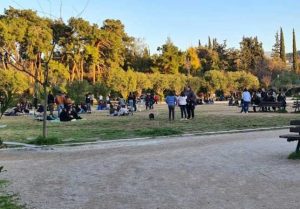Pedion Areos, the recration garden of Athens

This grove has an area of 277 acres together with Finopoulos hill. It is located North east of Omonia Square, from which it is 1 km away. The entire area of the grove belongs to the State.
It is surrounded today, from West to East and Ssouth, by Mavrommataion, Evelpidon streets and by Alexandras avenue. At the entrance of the grove, at the confluence, is the equestrian statue of King Constantine I. On the Alexandras Avenue side there is the memorial to the fallen British, Australians and New Zealanders with the statue of Athena on a high pedestal. Also within the grove are other monuments such as those of Alexander Ypsilantis and other notables.
In 1927, this area, which since the time of King Otho was the main place of recreation for the Athenians, was granted to the “Committee of Public Gardens and Arboretums of Athens” established at the time, with the aim of transforming it into a grove, like the then Royal Garden (later the National Garden) . However, that Committee, first took care to improve the garden of Thission, and the National Garden, consequently, six years later, in 1933, with the small resources it had, it decided to start renovation and tree-planting works, on the one hand with then insurmountable administrative obstacles, and on the other hand with a great lack of money, for the continuation of the project. Thus, with a low in 1934, the so called “Special Fund for Permanent Pavements of Athens” (a new government body at the time) undertook to pay the costs.

The tree planting and regeneration works began in 1935 and continued under the government of Ioannis Metaxas until 1940, when World War II was declared. In that five-year period, approximately 46,000 trees and shrubs were planted. According to the plan, the planting of deciduous trees was followed in order to provide rich shade in the summer, and not to block the sun’s rays in the winter.
A fountain was placed in the central square of the grove and Mediterranean plants were planted around it, so that trees, bushes and flowers present the most beautiful and natural combinations of colors during the different seasons. After the liberation in October 1944, irrigation of the grove was ensured.
On the north side of the park towards Kypseli, to the east are the facilities of the Army Geographical Service, and to the west are the sports facilities of the Panhellenic gymnastic organisation.
Within the park there are also a children’s playground, the Aliki open amphitheater, which is sometimes used for performances, events or concerts, and two temples. On the north-eastern side towards Alexandras Avenue, is the church of Agios Charalambos and in the center to the west is the church of Taxiarches.
On the south side, on Alexandras Avenue, there was a swimming pool which in the mid-1950s was already in disuse. In the late 1950s, the summer stage of the Greek People’s Theater of Manos Katrakis was created in the pool area. The piazza was originally made on the bottom of the pool which was sloped and later levels of scaffolding were added. The stage was at the water’s edge, taking advantage of the existing height difference. Also, a closed entrance from Alexandras Αωενθε with cash registers and auxiliary areas was created.
After 1974, the space was auctioned again and the theater was taken over by the famous Greek actress Aliki Vougiouklaki. She mainly staged musicals such as My Fair Lady, Cabaret and Annie. The pool was demolished and simple constructions were made that enlarged the spectator area. In 1984, the theater closed for good. In the 2019 renovation, it was converted into a grassy slope suitable for outdoor events
